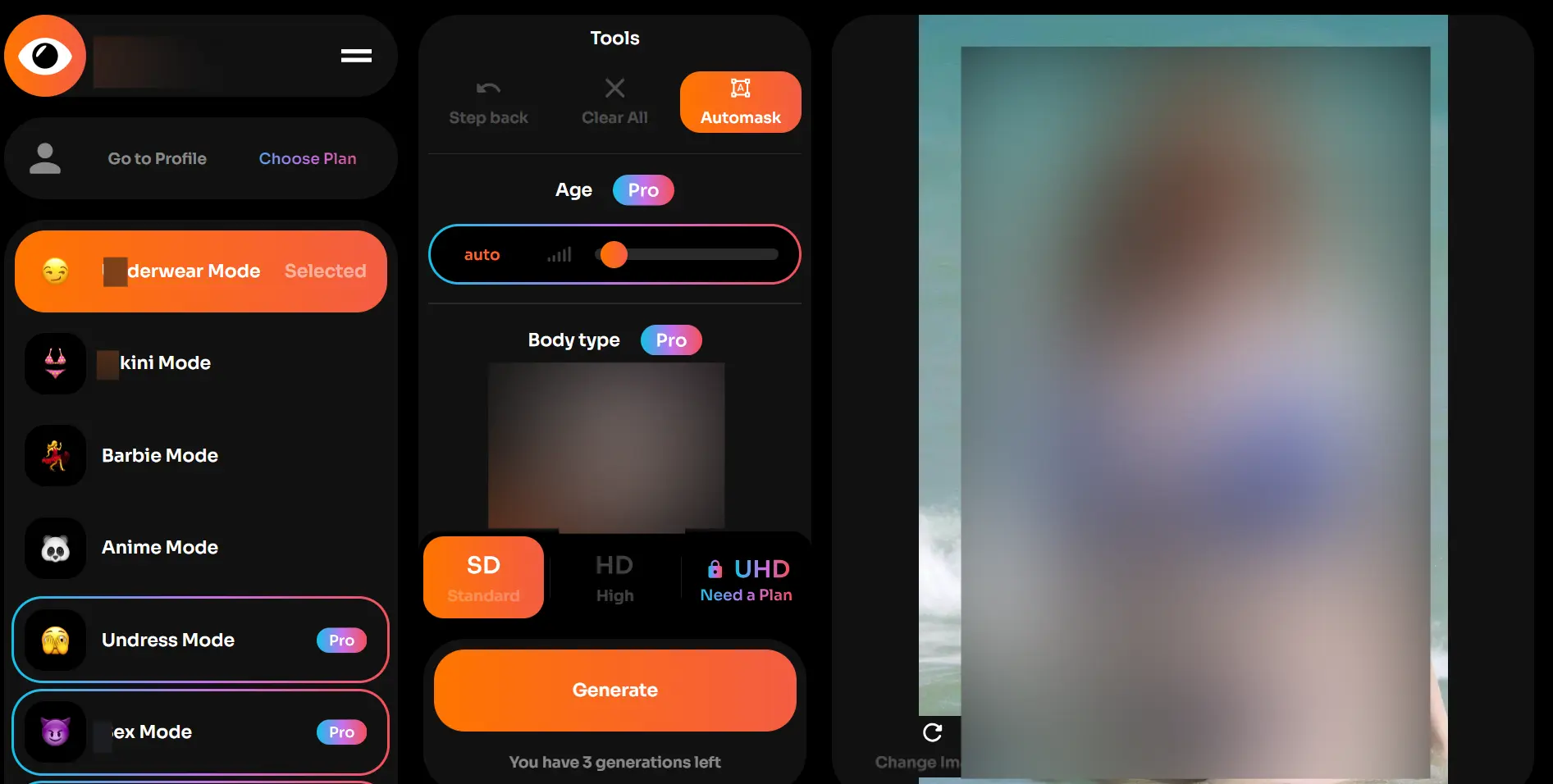AI Clothes Remover: Try Free Today & Transform Images!
In a world rapidly reshaped by artificial intelligence, could you imagine a tool that can digitally alter reality with a few clicks, making the seemingly impossible effortlessly achievable? The rise of AI-powered image manipulation tools is here, presenting both thrilling creative possibilities and significant ethical considerations.
The digital age has ushered in an era of unprecedented technological advancement, and at the forefront of this revolution is artificial intelligence. Within the realm of image manipulation, AI has introduced tools that can perform tasks once considered the exclusive domain of skilled professionals. One of the most intriguing applications of this technology involves the ability to digitally remove clothing from images, a capability that has sparked considerable discussion and debate. These tools, often referred to as "AI clothes removers" or "undress AI" apps, utilize sophisticated algorithms to analyze and modify images, creating the illusion of nudity. Their potential applications span a wide spectrum, from creative endeavors to professional applications, but they also raise significant questions regarding privacy, consent, and the responsible use of technology.
The core functionality of these AI tools revolves around deep learning models, which are trained on vast datasets of images to recognize and understand the patterns and textures of clothing and the human body. This training allows the AI to identify clothing in an image, "remove" it digitally, and reconstruct the underlying form with a degree of realism that varies depending on the specific tool and the quality of the input image. The process typically involves uploading an image, selecting a desired level of alteration, and allowing the AI to process the image. The result is an altered photograph that can appear strikingly realistic, blurring the lines between the original and the modified version. These tools have gained popularity for both their ease of use and the surprising quality of their output.
These AI-powered tools are not merely novelties; they offer a diverse range of applications. Consider the fashion industry, where designers can use them to visualize how garments drape on different body types without the need for physical prototypes. For artists and creatives, they open up new avenues for artistic expression, allowing for the modification and enhancement of images in ways previously unimaginable. Even in the realm of forensic science, these tools can be used to enhance or recover images, although, their use must be approached with utmost caution, respecting the legal and ethical boundaries.
These tools provide creative ways to modify images. "Remove clothes and items in your pictures in creative ways that are easy to do," offering users the ability to experiment with different styles and aesthetics. Moreover, the speed and efficiency with which these tools operate are remarkable. "Modify your images in seconds with just a few clicks, delivering precise and personalized results every time," claims one such service.
The evolution of these AI tools is not without its challenges. One of the primary concerns is the potential for misuse and abuse. The ability to generate realistic nude images from existing photographs raises serious questions regarding privacy and consent. Without appropriate safeguards, these tools could be used to create non-consensual explicit images, causing significant harm to individuals and damaging their reputations. Protecting user data and ensuring the ethical use of these AI technologies are paramount.
The ethical implications of AI clothes removers extend beyond the realm of personal privacy. The technology's ability to alter images in a way that can be difficult to detect raises concerns about the spread of misinformation and the manipulation of public discourse. Images can be altered to portray individuals in ways that are inaccurate or misleading, leading to reputational damage or, in extreme cases, inciting violence. The development and implementation of regulations to govern the use of these tools are essential to mitigate the risks associated with their misuse.
To understand the landscape of AI clothes removers, one must explore some of the tools available. Services like "Undressher AI," claim to ensure the security and confidentiality of uploaded images. "Our ai clothes remover ensures that any uploaded and processed images are safe, guaranteeing that your information remains secure and confidential," says its promotional material. Platforms such as "undress.app" and "undresserai.io" offer innovative tools and features, using advanced AI to provide seamless and realistic results.
Furthermore, platforms like "Nudify ai" and "Seaarts ai clothes remover" leverage advanced technology to generate "deepnude art." Moreover, tools like "Muke's undress ai" offer users the ability to upload photos and remove clothing. These platforms frequently emphasize the ease of use. "Easily remove clothes from photos online or swap clothes from any photo using the free ai clothes remover," states one service. "Tap the upload button to load your photo to ptool's ai clothes remover tool. Tap the generate button to erase the clothes using ai and swap it to the new outfit style you prefer."
| Feature | Details |
|---|---|
| Technology Used | Artificial Intelligence, Deep Learning models |
| Functionality | Detects and removes clothing from images, generating altered versions |
| Applications | Creative projects, fashion design, forensic science, artistic endeavors |
| Ethical Considerations | Privacy, consent, potential for misuse, risk of misinformation, non-consensual content creation |
| Customization Options | Adjustments for body type, age, skin tone, gender, and other personalized features |
| Ease of Use | Simple interface, quick processing, and easy to navigate |
| Pricing | Offer free trial and premium plans for extended capabilities and faster service. |
| Key Terms | AI clothes remover, Undress AI, Deepnude, Image manipulation, Digital alteration, Nudify AI, Cloth remover AI |
| Security | Services ensure uploaded images are safe, guaranteeing secure information |
| Examples | Undressher AI, undress.app, undresserai.io, Nudify AI, Seaarts AI clothes remover, Muke's undress AI, Unclothy, Clothoff, Anieraser's AI clothes remover. |
| Reference Website | Wikipedia: Artificial Intelligence |
The development of these AI tools also comes with questions about the limitations of the technology itself. While AI can generate increasingly realistic results, the quality of the output still depends on factors like the quality of the input image, the complexity of the scene, and the specific algorithms used. Some tools may perform better with certain subjects, such as female figures, due to the nature of the training data. "The ai is trained on a large dataset to ensure realistic results, but it primarily performs best with female subjects due to the nature of its training data," mentions one service.
Moreover, the tools may not always produce perfect results, sometimes resulting in distortions or artifacts. This is where the skills of retouchers come in. They are professionals who can enhance the output from these AI tools or, in some cases, work on images manually. Retouchers need a deep understanding of human anatomy, the perspective of the body in space, and lighting to produce realistic alterations. "A feature of this function and methods of achieving the desired result is the professional skills of our retouchers," a service stated. "Understanding of the anatomy of the human body, the ability to see the perspective of the location of the body in space, taking into account lighting, including darkening and light sources."
The accessibility of these tools is another crucial factor to consider. Many services offer free trials or limited access to their features. However, premium plans often provide extended capabilities and faster service. This accessibility has democratized image manipulation, allowing a wider audience to experiment with and use the technology.
As the capabilities of AI continue to evolve, it is essential to establish clear ethical guidelines and regulations to govern the use of these tools. These regulations should address key issues, such as consent, data privacy, and the prevention of non-consensual content creation. Furthermore, efforts must be made to educate the public about the potential risks associated with AI-generated images and the importance of critical thinking when evaluating visual information.
In conclusion, AI clothes removers represent a fascinating intersection of technological innovation and ethical considerations. The potential benefits of these tools are clear, offering creative avenues for artists and designers while opening up possibilities in professional fields. However, the risks associated with misuse and the creation of non-consensual explicit content cannot be overlooked. As the technology continues to advance, it is essential to address the ethical and societal implications, prioritizing safety, privacy, and responsible use. Only through careful consideration and proactive measures can we navigate the complex landscape of AI-powered image manipulation and ensure that its benefits are realized while mitigating its potential harms.


